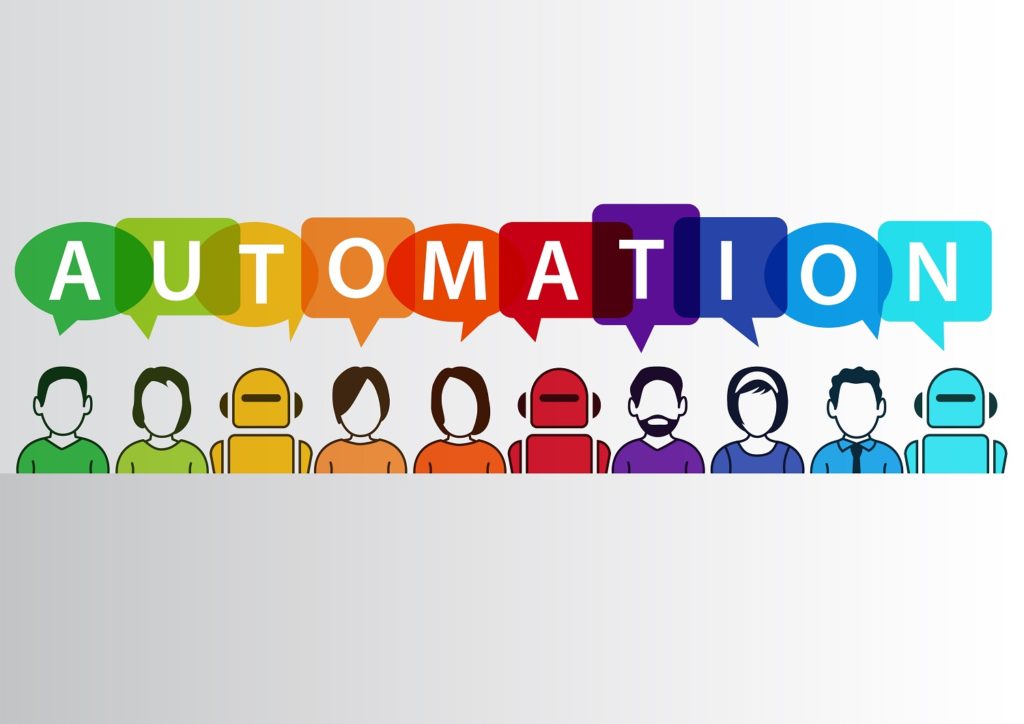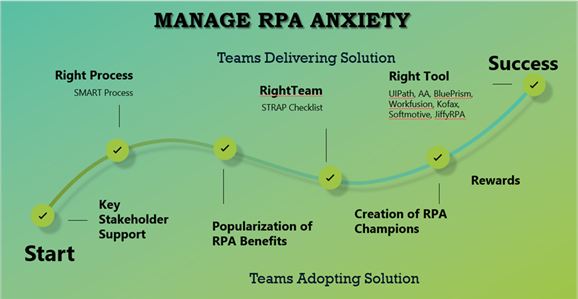COVID-19 has compounded the explosion of automation in many industries. Education, retail, banking, credit and financing, sales and distribution, recruitment and HR, and pharmaceuticals are all seeing a major acceleration in automation. For quick and immediate outcomes, RPA (Robotic Process Automation) will be widely adopted as a mode of automation by IT leaders as it can quickly address Straight-Through-Processing (STP) mechanisms, alongside other (more tightly coupled) forms of development such as microservices or streaming APIs.
However, RPA application mortality is very high. According to NTT, over a period of 7 years, among 1000 ideas mooted in organizations, only 20 BOTs finally enter and stay in production. There is an alarming failure rate in the process of going from an idea to a proof-of-concept, then to an enterprise-grade product. In the same report, NTT stated that even after successful POCs, 40% of all RPA projects do not go into development. While the quality of software tools that enable one to run bots have improved significantly since then, the grim story of RPA mortality rates is still quite high, even after allowing for the time period.
Naturally, this has led to a huge increase in RPA anxiety within organisations and across the ecosystem. Companies building intranet and extranet applications are affected on two fronts:
- Primarily, they are impacted by the change in customer expectations. Customers are screaming for automation. This has manifested itself through the transition to working from home, job losses, organisational restructuring, and skills retraining requirement. Cost reduction goals are at the forefront, even as companies have to grapple with potential revenue losses and margin impacts, and individuals are dealing with income losses. As a result, the responsibility to deliver such change is imperative.
- Secondarily, the technology teams have to match the high expectations of the end-user community on successful, seamless automation.
Managing RPA anxiety necessitates both:
- Driving RPA adoption with careful planning, adoption policies and change management to change organisational culture, and
- Rolling out the RPA program with care, superior technology, and BOT lifecycle planning.
Through our experiences managing several RPA projects at Digileap, we have found that below are the best ways to do so:
Tips for Managing RPA Anxiety- The Delivery Side
Technology teams need to manage the bot lifecycle by systematically planning the process, teams, exception management, and managing stakeholder expectations.
Choosing the Right Process to Automate
Choose processes that are highly repetitive, where business logic can be parameterised using the SMART methodology.
(S)tability– Select processes that will be STABLE in between bot upgrade cycles. A process prone to rapid change will require more complex RPA solutioning.
A bot that reads the news every day and categorises it into different categories, and is intelligent enough to dynamically include the creation of new categories needs to have a cognitive and machine learning component built in to help do this. Being unaware of the additional machine intelligence requirements can lead to long term failure.
(M)easurable– Processes that have structured, specific, and measurable inputs and outputs that align with business rules are ideal for RPA success.
For example, a bot that reads customer bank statements to give a loan based on established rules has a higher chance of business success than a bot reading the news to analyse the sentiment on a given article.
(A)ctionable– Actionable processes that require structured inputs and generates structured outputs are ideal for RPA success. Any process that has specific and predictable business rules over an acceptable period of time (whether it is a few weeks or several years) and reads digitised inputs and produces digitised outputs are ideal for most RPA products.
Optical character recognition (OCR), image recognition, facial recognition are distinct from traditional methods of capturing input from raw files, screens, PDFs, and emails. They are therefore good examples of inputs that can be made actionable. The same is relevant for output data.
On the other hand, transactions require personal or gut feeling decision-making within the context of a large segment of data. As a result, they are not necessarily good candidates for simple bots. Bots for contract reviews of documents that do not follow the same template every time are likewise poor candidates for robotic process automation.
(R)epetitive– A bot’s value is better realised when it is applied to repetitive processes. The frequency of repetition has a high correlation with the cost of bot development as well as its adoption. Automating repetitive processes give much higher returns on investment, all other things being equal.
(T)ransactional Process (with high volumes)- All processes cannot be automated unless they can be converted into digitalized software transactions. It is often found that many processes require man-machine interfaces that may be just too expensive or inconvenient to digitalize to be integration ready.
Choosing the Right Delivery Team

Use the STRAP methodology to ensure that your team has people equipped with the right skills and degree of ownership.
(S)pecialists (Business and Technical)– The ideal ratio of RPA tool certified specialists and business specialists within a team is somewhere between 4:1 and 7:1. The ideal candidate would have a detailed understanding of both RPA and the business. If such a candidate is not available, cross-training is essential to ensure that both types of specialists have a good appreciation of the strengths and limitations of the process and tools.
(T)ester–The tester has intimate knowledge of common and outlier exceptions that crop up and is capable of creating appropriate test cases for those exceptions. The absence of proper and detailed planning for exceptions management is a major cause of RPA project failure even after the projects go into production. This is typically a full time or part-time role, depending upon the complexity of the application.
(R)eferee– Rarely represented in RPA projects, the referee plays a critical role in ensuring buy-in from stakeholders from the start and possesses superior knowledge of the business processes in the team. This person is typically from the stakeholder team and should be nominated/appointed into the development scrum team. The referee is often a process owner or someone who directly reports to the process owner.
(A)rchitect– RPA project teams should have access to both a process and technical architect who periodically review the project.
(P)roject Leader – A strong project leader with excellent communication is a must. Such a leader needs a thorough understanding of RPA technology, its limitations, as well as the extensibility of RPA through external coding or use of libraries. When any of these roles are absent, organisations should use outsourcing providers like us to fill them.
Choosing the Right Tool
UIPath, Automation Anywhere, Blue Prism, Workfusion, Softmotive, Kofax, Jiffy RPA and many other tools are in the market. Different tools cause different dependencies. RPA application mortality is closely correlated with tool limitations, the skill level of the person using the tool, and the complexity of application requirements.
Tips for Managing RPA Anxiety-The Adoption Side

Unfortunately, even the best implementation can fail in the face of aggressive end-user resistance. Below are some practices that we at DigiLeap have found very useful:
Quickly Attain Key Stakeholder Support
We insist on the top management sending out formal/informal communications endorsing the productivity enhancement and reduction of costs through RPA adoption. We have consistently seen a marked improvement in adoption and success rates in organisations where the CEOs and CIOs have given their support by setting productivity goals for the year.
Popularise the Benefits of RPA
RPA is often wrongly perceived as being akin to hardware robots that may replace human beings at work. In reality, RPA is more like any other productivity application. It simply replaces the manual steps in between different processes. Given that most organizations have incorporated computers in their organisational lives in a big way, RPA fixes the broken element of such processes and has a much lower impact on the elimination of jobs, and helps in eliminating errors.
The popularisation of such benefits through workshops, training, organizational certifications, discussions, posters, formal emails, rewards, and active evangelism is very useful.
Create RPA Champions
We have consistently found that making the process owner an RPA Champion or RPA Evangelist is one of the best ways to create a positive impact. Recording the RPA Champion’s personal success story either on video, audio, company newsletter or internal portal usually helps in widespread positive sentiment.
Gamifying and Rewarding Adoption
Adopting a competitive framework blessed by senior management to popularize internal adoption creates a healthy environment. As well as the creation of few accolades like a “Best RPA Application” award, “Fastest RPA Implementation” award, “Most Improved Application” award, and “Highest RPA Literacy” Awards go a long way in promoting sentiments.
Conclusion
Given the twin pressures of high expectations from RPA and the inherent nature of high RPA application failure, it is natural for both the delivery side and adoption sides to face RPA anxiety – albeit for completely different reasons. It is important to adopt the key best practices listed above, as well as seek senior management support to avoid such anxiety and deliver successful RPA projects.












